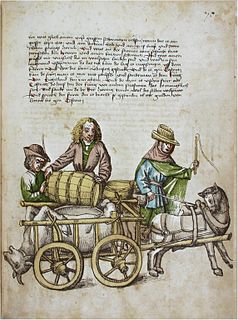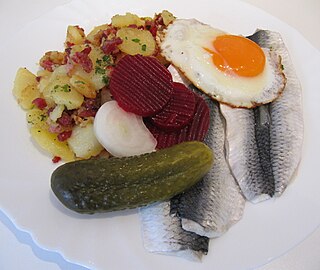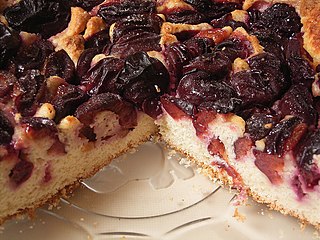
Cake is a form of sweet food made from flour, sugar, and other ingredients, that is usually baked. In their oldest forms, cakes were modifications of bread, but cakes now cover a wide range of preparations that can be simple or elaborate, and that share features with other desserts such as pastries, meringues, custards, and pies.

An apple pie is a pie in which the principal filling ingredient is apples. The earliest printed recipe is from England. Apple pie is often served with whipped cream, ice cream, or cheddar cheese. It is generally double-crusted, with pastry both above and below the filling; the upper crust may be solid or latticed. The bottom crust may be baked separately ("blind") to prevent it from getting soggy. Deep-dish apple pie often has a top crust only. Tarte Tatin is baked with the crust on top, but served with it on the bottom.

Marzipan is a confection consisting primarily of sugar, honey, and almond meal, sometimes augmented with almond oil or extract.

Fruitcake is a cake made with candied or dried fruit, nuts, and spices, and optionally soaked in spirits. In the United Kingdom, certain rich versions may be iced and decorated.

Lithuanian cuisine features products suited to the cool and moist northern climate of Lithuania: barley, potatoes, rye, beets, greens, berries, and mushrooms are locally grown, and dairy products are one of its specialties. Various ways of pickling were used to preserve food for winter. Soups are extremely popular, and are widely regarded as the key to good health. Since it shares its climate and agricultural practices with Northern Europe, Lithuanian cuisine has much in common with its Baltic neighbors and, in general, northern countries. Longlasting agricultural and foraging traditions along with a variety of influences during the country's history formed Lithuanian cuisine.

Stollen is a fruit bread of nuts, spices, and dried or candied fruit, coated with powdered sugar or icing sugar and often containing marzipan. It is a traditional German bread eaten during the Christmas season, when it is called Weihnachtsstollen or Christstollen.
Romanian cuisine is a diverse blend of different dishes from several traditions with which it has come into contact, but it also maintains its own character. It has been mainly influenced by Turkish and a series of European cuisines in particular from the Balkans, or Hungarian cuisine as well as culinary elements stemming from the cuisines of Eastern and Central Europe.

Coffee cake may refer to a sponge cake flavored with coffee or, in the United States, a sweet cake intended to be eaten with coffee or tea. A coffee-flavored cake is typically baked in a circular shape with two layers separated by coffee butter icing, which may also cover the top of the cake. Walnuts are a common addition.

Raisin bread is a type of bread made with raisins and flavored with cinnamon. It is "usually a white flour or egg dough bread". Aside from white flour, raisin bread is also made with other flours, such as all-purpose flour, oat flour, or whole wheat flour. Some recipes include honey, brown sugar, eggs, or butter. Variations of the recipe include the addition of walnuts, hazelnuts, pecans or, for a dessert, rum or whisky.

Cozonac or Kozunak is a special sweet leavened bread, traditional to Southeastern Europe, Romania, Bulgaria and Serbia, Macedonia, Greece, etc. Rich in eggs, milk and butter, it is usually prepared for Easter in Romania, Serbia, Bulgaria, and mostly for every major holiday in Romania and Moldova. The name comes from the Greek word for hair-коса/kosa, or Greek: ϰοσωνάϰι kosōnáki, a diminutive form of ϰοσώνα kosṓna.

Genoa cake is a fruit cake consisting of sultanas, currants or raisins, glacé cherries, almonds, and candied orange peel or essence, cooked in a batter of flour, eggs, butter and sugar.

A Franzbrötchen is a small, sweet pastry baked with butter and cinnamon, similar to a cinnamon roll. Sometimes other ingredients are used as well, such as chocolate or raisins. It is a type of pastry commonly found in northern Germany, especially Hamburg, and it is usually served for breakfast, but is also enjoyed along with coffee and cake. As its name indicates, the Franzbrötchen was probably inspired by French pastries. Originally, it could be found only in the region of Hamburg, but now Franzbrötchen are also sold in Bremen, Berlin, and other German cities.

Kerststol is a traditional Dutch oval-shaped fruited Christmas bread. The yeast-based bread contains dried fruits, raisins and currants, lemon and orange zest, water, milk, butter, sugar, vanilla and cinnamon. A more luxurious variety may include chopped walnuts, almonds, or hazelnuts. Ginger powder or grated crystallized ginger, dried cherries and cranberries, apple, kiwi or cardamom may also be added to this pastry dough.

Allerheiligenstriezel or simply Strietzel is a braided yeast pastry. Its name means "All Saints' braid" in English and it consists of flour, eggs, yeast, shortening or butter, raisins, milk, salt, and decorating sugar or poppy seeds. Some regional variations also include rum or lemon juice.

Due to its centuries-old history as a major port town the cuisine of Hamburg is very diversified and sapid as ingredients’ supply was safe. Until the 20th century the cuisine of Hamburg was predominantly characterized by the extensive choice of different kinds of fish from the river Elbe and the nearby Baltic Sea. The region of Vierlande supplied Hamburg with fresh vegetables. Fruit came from the area Altes Land and until industrialization the neighbourhood of Wilhelmsburg was considered the ‘milk isle’ of Hamburg. International trade in the Port of Hamburg made spices and exotic nutrition items from India and South America available since the 16th century which were soon incorporated into civic kitchens. On this basis the cuisine of Hamburg developed which regrettably lost some of its characteristics nowadays due to the supraregional harmonization of the North German cuisine. But due to its high economic importance Hamburg does feature many internationally recognized gourmet restaurants from which 11 were repeatedly awarded with a Michelin star in 2010.

A spit cake is a European-styled cake made with layers of dough or batter deposited, one at a time, onto a tapered cylindrical rotating spit. The dough is baked by an open fire or a special oven, rotisserie-style. Generally, spit cakes are associated with celebrations such as weddings and Christmas. The spit can be dipped in a thin dough, or the dough can be poured or rolled on the spit.

Plum cake refers to a wide range of cakes made with either dried fruit or with fresh fruit. There is a wide range of popular plum cakes and puddings. Since the meaning of the word "plum" has changed over time, many items referred to as plum cakes and popular in England since at least the eighteenth century have now become known as fruitcake. The English variety of plum cake also exists on the European mainland, but may vary in ingredients and consistency. Settlers in British colonies brought the dried fruit variety of cake with them, so that for example, in India it was served around the time of the Christmas holiday season and in the American colonies, where it became associated with elections, one version came to be called "election cake".
Breudher, also known as Brueder or Bloeder, is a traditional Sri Lankan Dutch Burgher buttery yeast cake, baked in a fluted mould. A variation, Bleuda, Kueh Bleuda or Kue Bludder is also found in the Malacca Dutch Eurasian community and in Kochin, a city in the south-west of India.
















